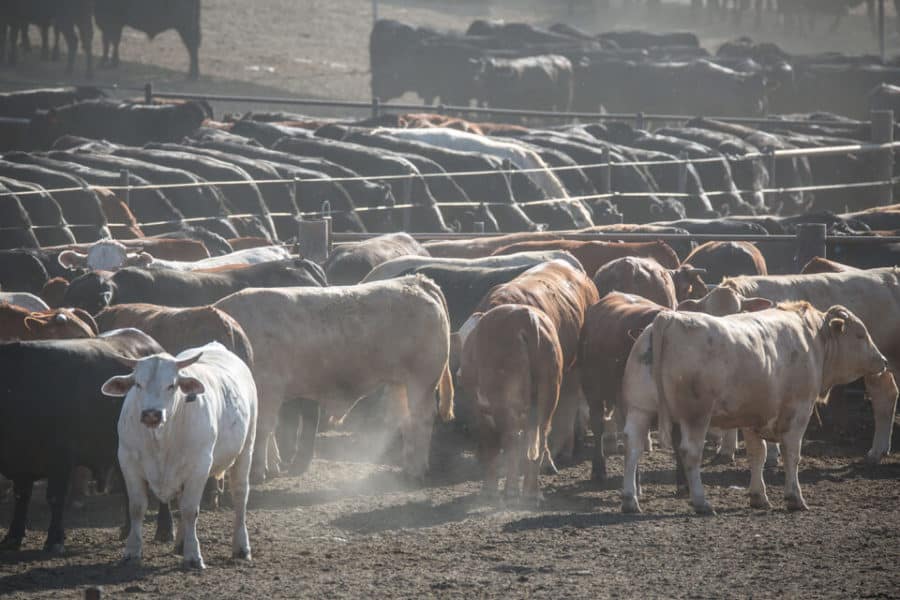Changing dietary patterns in the U.S. are leading to lower emissions of food-related, climate-warming gases, according to a new research study, and half of the reduction can be attributed to eating less beef.
Every choice we make as consumers has a climate impact, which is often measured in terms of its “carbon footprint” — that is, the amount of greenhouse gases emitted in the process of producing a good or providing a service.
“The greenhouse gases of our food system are one of the largest portions of our footprint as a nation,” says Clare Bassi, who led the new study, which was published recently in the Journal of Cleaner Production, as a master’s student at the University of Wisconsin–Madison. Globally, food systems contribute about one-quarter of all human-caused greenhouse gas emissions.
It can be hard for consumers to know how specific food choices relate to overall climate impact. The carbon footprint of a food item includes emissions associated with its production, processing, transportation, cooking and waste. And different foods have very different environmental impacts — animal products and processed foods are often much more carbon-intensive than minimally processed and plant-based foods.
The new study explores the carbon footprint of Americans’ eating patterns and how they have changed in recent decades.
“I wanted to see where the impacts of climate change were in our diets and how they were changing over time,” says Bassi. She also examined trends based on demographic factors, such as sex, age, household income, and race/ethnicity.
Bassi analyzed eating habits reported each year from 2003 to 2018 and calculated the average daily greenhouse gas emissions associated with diet. In just 15 years, the carbon footprint of the U.S. diet fell by more than 35%, mostly due to Americans eating less meat and other carbon-intensive foods. Lower consumption of beef, dairy, chicken, pork, and eggs accounted for more than 75% of the observed diet-related carbon dioxide savings during the study period; beef alone was responsible for nearly half of the drop.
“The trend is quite exciting,” Bassi says. “Over the study period, national greenhouse gas savings from dietary changes alone is roughly equivalent to offsetting emissions from every single passenger vehicle in the country for nearly two years.”
As an individual, sometimes it feels like you don’t have much power to make positive change, Bassi notes. But her findings show that “our collective behavior changes are making a difference,” she says. By choosing foods with a smaller carbon footprint, “you can feel empowered that you can reduce your impact in a significant way.”
Bassi calculated greenhouse gas emissions based on individual daily diets reported by more than 39,000 U.S. adults in the National Health and Nutrition Examination Survey between 2003 and 2018. She looked at how the averages changed over time and examined trends based on demographic factors, such as sex, age, household income, and race/ethnicity.
Every demographic subgroup she analyzed showed a 30% to 50% reduction in diet-related greenhouse gas emissions during the study years. In general, females ate lower-impact diets than males. Females had an average food-related carbon footprint of about two kilograms of carbon dioxide emissions per person per day in 2018; for males, it was about three kilograms per person per day.
When the data were grouped by race/ethnicity, average carbon footprint was slightly higher among Hispanics compared with non-Hispanic whites and lowest among Blacks. In a breakdown by income level, diet-related carbon footprint was greatest in the highest income group (annual household income more than 1.84 times the federal poverty level, or about $46,000 for a family of four in 2018) and lowest in the lowest income group (annual income less than 1.3 times the poverty level, or $32,600 in 2018).
The lowest income group also showed the largest percentage reduction, 46.4%, between 2004 and 2018, compared with 39.3% in the highest income group. When analyzed by age group, the youngest eaters showed the largest reduction in diet-related carbon emissions, with a 15-year drop of 47.2%.
“All of that saving is essentially from people eating less greenhouse gas-intensive foods,” Bassi says. Calorie intake stayed steady over the years of the survey, and the analysis used constant values for emissions related to production and other systemic factors to focus just on changes due to eating patterns.
These positive trends are encouraging, she notes, but Americans are still exceeding our fair share of food-related emissions compared to other parts of the world. A 2019 scientific report from the international EAT-Lancet Commission identified global thresholds for diet-related greenhouse gases that would adequately feed the world’s population while keeping global warming below 2° C by 2050. The average U.S. diet-related carbon footprint in 2018 was still nearly twice as high as the global targets, she says.
“People’s actions are making a difference,” Bassi says, “but we still have a long way to go.”
Bassi completed the research as a master’s student at the University of Wisconsin–Madison’s Nelson Institute for Environmental Studies and the Wisconsin Energy Institute. The paper was co-authored with Rachael Maysels of the University of Cauca in Colombia and UW–Madison professor of biological systems engineering Rob Anex.


